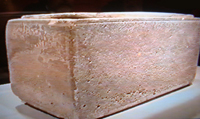Nazareth – The Town that Theology Built
The Lost City
The Gospels tell us that Jesus’s home town was the ‘City of Nazareth’ (‘polis Natzoree’):
And in the sixth month the angel Gabriel was sent from God unto a CITY of Galilee, named Nazareth, To a virgin espoused to a man whose name was Joseph, of the house of David; and the virgin’s name was Mary.
(Luke1.26,27)
And all went to be taxed, every one into his own city. And Joseph also went up from Galilee, out of the CITY of Nazareth, into Judaea, unto the city of David, which is called Bethlehem; because he was of the house and lineage of David:
(Luke 2.3,4)
And all went to be taxed, every one into his own city. And Joseph also went up from Galilee, out of the CITY of Nazareth, into Judaea, unto the city of David, which is called Bethlehem; because he was of the house and lineage of David:
(Luke 2.3,4)
But when he heard that Archelaus did reign in Judaea in the room of his father Herod, he was afraid to go thither: notwithstanding, being warned of God in a dream, he turned aside into the parts of Galilee: And he came and dwelt in a CITY called Nazareth: that it might be fulfilled which was spoken by the prophets, He shall be called a Nazarene.
(Matthew 2.22,23)
And when they had performed all things according to the law of the Lord, they returned into Galilee, to their own CITY Nazareth. And the child grew, and waxed strong in spirit, filled with wisdom: and the grace of God was upon him.
(Luke 2.39,40)
Sepphoris – an ersatz Nazareth?
In reality, in the early 1st century, Sepphoris was no larger than several acres, an erstwhile Herodian palace-town destroyed by Varus, the Roman governor of Syria, in 4 BC. Sepphoris reemerged as an ill-planned townlet during the time of Antipas. Only in the late 1st and 2nd centuries, particularly after the Jewish wars, did a vibrant, Romanised Sepphoris emerge, with theatres, bath houses and all the other amenities of pagan civilisation.
Downsizing
Be that as it may, was there even a tiny village?
'Never heard of the place' – Josephus
At a later time – as pottery and other finds indicate(see below) – the Nazareth site was re-occupied. This was after the Bar Kochba revolt of 135 AD and the general Jewish exodus from Judea to Galilee. The new hamlet was based on subsistence farming and was quite unrelated to the previous tomb usage by the people of Japha.
The archaeological evidence?
Christian Hero No 1. 1955-1960 Excavations conducted by Father Bellarmino Bagatti (Professor, Studium Biblicum Franciscanum at Flagellation, Jerusalem).
Beneath his own church and adjoining land, Bagatti discovered numerous caves and hollows. Some of these caves have obviously had a great deal of use, over many centuries. Most are tombs, many from the Bronze Age. Others have been adapted for use as water cisterns, as vats for oil or as ‘silos’ for grain. Apparently, there were indications that Nazareth had been ‘refounded’ in Hasmonean times after a long period when the area had been deserted. Yet overwhelmingly, archaeological evidence from before the second century is funerary. Obliged to admit a dearth of suitable evidence of habitation, none the less, Bagatti was able conclude that 1st century AD Nazareth had been ‘a small agricultural village settled by a few dozen families.’
Christian Hero No 2. 1996 -1997 Dr. Pfann (Franciscan School of Theology) digs at Nazareth.
In November 1996 Stephen Pfann of the Center for the Study of Early Christianity began an investigation of agricultural terraces in the grounds of Nazareth Hospital. What Pfann and his crew came up with was a vaguely-dated winepress, described as ‘ancient’. Potsherds were also found on the surface of the terraces, dating from various periods ‘beginning with the early to late Roman periods.’

Excavations by Michael Avi-Yonah at Caesarea in 1962:
‘The eighteenth priestly course [called] Hapizzez, [resettled at] Nasareth.’
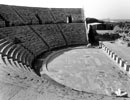
Getting a Name
– Gospel of Philip, 47.
What we do know is that ‘Nazarene’ (or ‘Nazorean’) was originally the name of an early Jewish-Christian sect – a faction, or off-shoot, of the Essenes. They had no particular relation to a city of Nazareth. The root of their name may have been ‘Truth’ or it may have been the Hebrew noun ‘netser’ (‘netzor’), meaning ‘branch’ or ‘flower.’ The plural of ‘Netzor’ becomes ‘Netzoreem.’ There is no mention of the Nazarenes in any of Paul’s writings, although ironically, Paul is himself accused of being a Nazorean in Acts of the Apostles. The reference scarcely means that Paul was a resident of Nazareth (we all know the guy hails from Tarsus!).
The writer of Matthew (re-writer of the proto-Matthew stories) heard of ‘priestly’ families moving to a place in Galilee which they had called ‘Nazareth’ – and decided to use the name of the new town for the hometown of his hero.
Dodgy Story, Dodgy Geography
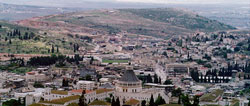
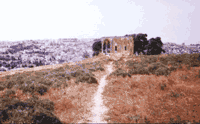
‘Mount of Precipice’ (aka ‘Lord’s Leap’)
It would take quite some time to get from the downtown ‘synagogue’ and scramble to the top of the ‘cliff’!
The Town that Theology Built
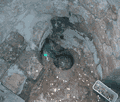
‘Mary’s Well’: A hole in the ground evidence for Holy Family (about as convincing as an empty tomb)
4th Century Pilgrim Route – and NO NAZARETH!
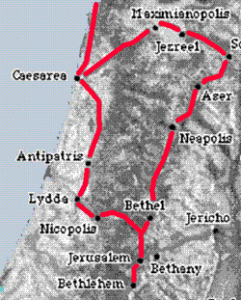
4th Century Roman Map – and NO NAZARETH!
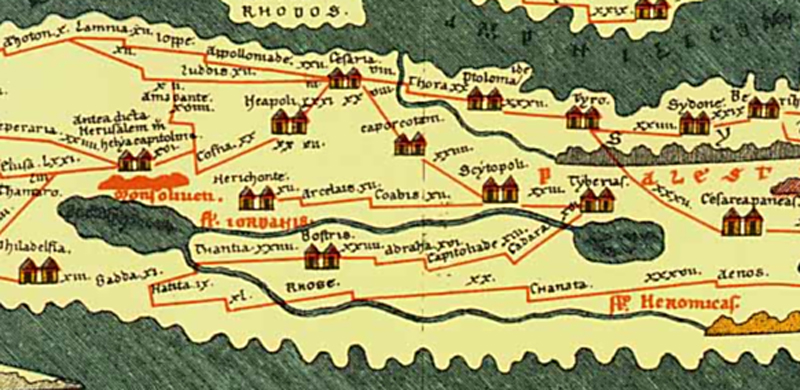

Grotto beneath Basilica of the Annunciation. Mary’s ‘maiden home’ (or even home of the holy family, if you prefer)
In 636 Arab armies overran Byzantine possessions in Palestine, including Nazareth. A Christian presence continued in the area, though it was subject to restrictions and heavy taxes. Nearly five centuries later, Crusaders occupied the valley and built a fort. On the foundations of the earlier Byzantine ‘grotto’ church they built something a little grander, more befitting their resident bishop.
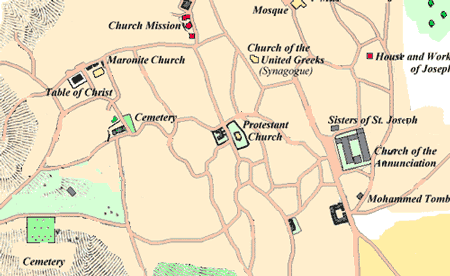
Old town Nazareth – an ecclesiastic theme-park
Sources:
- René Salm, The Myth of Nazareth (Kevalin, 2007)
- Dan Cohn-Sherbok, The Crucified Jew (Harper Collins,1992)
- Henry Hart Milman, The History of the Jews (Everyman, 1939)
- Josephus, The Jewish War (Penguin, 1959)
- Jonathan Reed, Archaeology and the Galilean Jesus: A Re-examination of the Evidence (Trinity, 2002)
- Leslie Houlden (Ed.), Judaism & Christianity (Routledge, 1988
- Karen Armstrong, A History of Jerusalem (Harper Collins, 1999)
- Jonathan N. Tubb, Canaanites (British Museum Press, 1998)
- Norman Cantor, The Sacred Chain – A History of the Jews (Harper Collins, 1994)
Good for Business
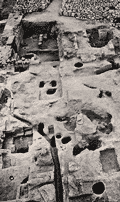
Road to Nowhere
The Archaeological Record:
Misusing the evidence
Coins Found ...
Cavemen?
"The Nazareth Decree"
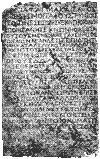
Locals fix a miracle for the tourists
Christmas Special - another Christian Theme Park Attraction
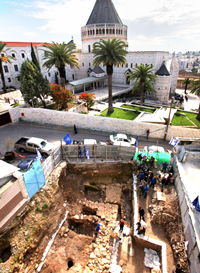
"Jesus bathhouse"
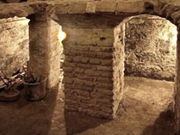
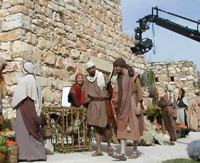
Ubiquitous sun-god
Theology First ...

